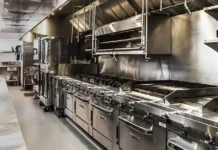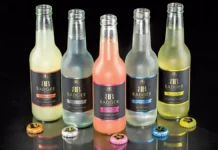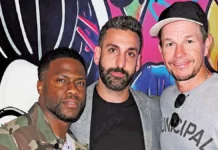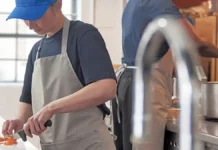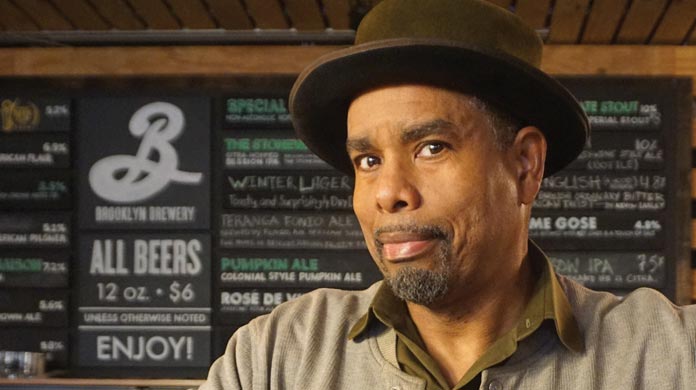
Like many college graduates, Garrett Oliver found that his initial career path as a paralegal lacked passion. So when the opportunity to work in a hobby he loved, the Manhattan native jumped at the chance despite having to take a pay cut.
Beginning his career as an apprentice at Manhattan Brewing Company in 1989, Garrett Oliver quickly rose to prominence as an expert in the field. He climbed the ranks at Manhattan Brewing and was appointed brewmaster in 1993, before departing to head up operations at Brooklyn Brewery from 1994 to the present.
Today, he has grown to be the Brewmaster of The Brooklyn Brewery. He is one of the foremost authorities in the world on the subject of beer. A host of more than 800 talks and tastings, at venues ranging from the Smithsonian to the James Beard House in 12 countries over the past two decades, he is perhaps best known as the author of the award-winning book The Brewmaster’s Table.
Garrett Oliver has made many appearances on television and in other media, writes regularly for food and beer-related periodicals, and is a veteran judge of professional brewing competitions. He was a founding Board member of Slow Foods USA, and a James Beard “Outstanding Wine or Spirits Professional” Award finalist in both 2009 and 2010.
With a full glass of travel and teaching obligations, his primary occupation remains the creation of The Brooklyn Brewery’s legendary range of beers. Total Food Service had the opportunity to visit with Garrett Oliver in the company’s Brooklyn facility. TFS tasted the latest that included everything from a seasonal brew aged in bourbon barrels to a lighter key lime tasting offering. Most importantly, TFS got the chance to get his thoughts on the growth of beer in restaurants and hospitality.
Who are the entrepreneurs and visionaries behind the launch of the company? Can you share a little of their history?
The Brooklyn Brewery was founded in 1988 by Steve Hindy and Tom Potter. Steve was a war correspondent and newspaper editor and Tom was a lending officer at a bank. When stationed in the Middle East, reporters often had no access to alcoholic beverages, so the enterprising people made their own. Drinking these full-flavored home-brewed beers, Steve came to realize that beer could be more than a thin-flavored fizzy yellow drink. He talked Tom, his upstairs neighbor and sometimes home-brewing partner, to go into business with him, and The Brooklyn Brewery was born.
Can you talk about growing up? What got you interested in beer?
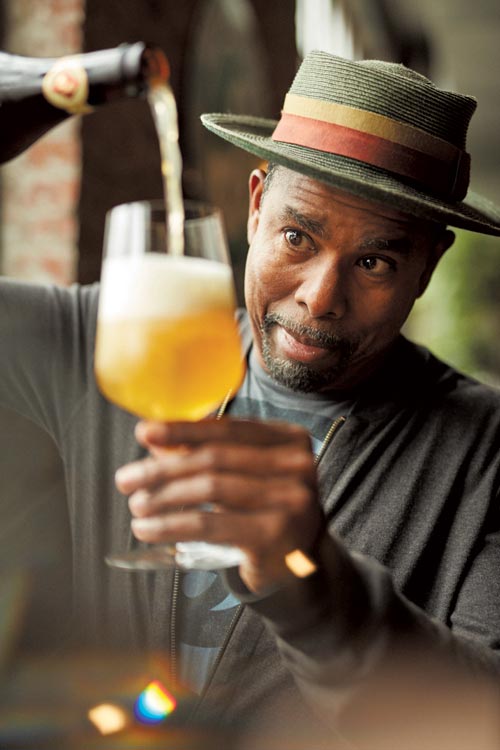
My father was an artist, having graduated from the famous Rhode Island School of Design (RISD), of which he was later a trustee. He started working on Madison Avenue as an art director and then creative director for the major advertising firm of Young & Rubicam. My mother was the assistant membership director of The New York Academy of Sciences. Given that I often say that craft brewing is half art and half science, I sometimes think that it’s no accident that I became a brewer. I fell in love with beer while living in London in the early 1980s. I had a degree in Broadcasting and Film, but in London I stage-managed rock bands. And when I wasn’t producing shows, I was going to the pub – traditional British beer was a revelation to me.
You have an amazing brother in Roger? What impact has he had on who you are?
Roger has so many talents that I sometimes joke that I became a brewer just to get out from under his shadow, even though I’m the older brother by two years. He’s an excellent musician and singer (I’ve seen him pretty much make a whole room of people cry with just his voice and a guitar), a great communicator and people person, and can staff an entire food service department in a single bound through his work at the staffing agency Tempositions. I’m not sure that any one man should have so many powers, but at least he’s on my side!
How did you come to focus on beer as a career?
I feel that in a way, beer chose me. It started as a hobby – when I got back to the States, there was no decent beer to drink. I’d been all over Europe and had tasted so many wonderful things, but we only had industrial beer, and I didn’t want that stuff anymore. So I started brewing at home. I wasn’t interested in brewing per se; I just wanted the beer. Slowly but surely, brewing took over my life. It was a slippery slope, and eventually I fell in, starting work as an apprentice at Manhattan Brewing Company in SoHo in 1989.
What brought you to Brooklyn Brewery?
When it came time to build a brick-and-mortar brewery in Brooklyn (all the beer had previously been brewed in Upstate New York), Steve and Tom came to see me. I’d already gained some notoriety as brewmaster at Manhattan Brewing Company. I had other plans at the time, but they talked me into partnering with them. I joined Brooklyn Brewery in 1994 and helped design and build the brewery, which opened in March of 1996. There were only two beers then; Brooklyn Lager and Brooklyn Brown Ale. Today we make about two dozen different beers every year and sell them in 38 countries.
You and I spoke about the changes in Brooklyn, I asked you if you ever saw it becoming hip. It surely did… kind of the same thing that happened to beer?
I’m not sure that it was possible to foresee the rise of Brooklyn as a place and as a brand in of itself, but of course Brooklyn already had a storied history in everything from baseball to beer. In the 1890s there were 48 breweries in Brooklyn alone, and those breweries made about 15% of all the beer in the United States. And Brooklyn, being the ultimate melting pot engine of NYC, was always a great place. Like a lot of NYC, it had ups and downs, but these days the direction is straight up.
What led to beer becoming so hot? Were there people that just hated wine and signature cocktails? (Just kidding)
Craft beer has become hot for the same reason that good bread, artisanal cheese, ice creams, olive oil, great coffee, real cocktails, and now natural wine have become hot. Craft beer is real beer, and real beer was always terrific. Back in the days when a lot of us were only eating white store-bought industrial bread, we didn’t exactly “love” bread. But these days you get a nice sourdough loaf and some serious butter and everyone swoons. Now there’s a bread aisle and a cheese section and dozens of yogurts at the supermarket, but this stuff is not new… it’s old. But in the 60s, 70s and 80s most of America forgot what real food was about. Now we’re remembering, and it turns out that we want the good stuff. One thing you’ll find – almost all great brewers love good wine and cocktails too!
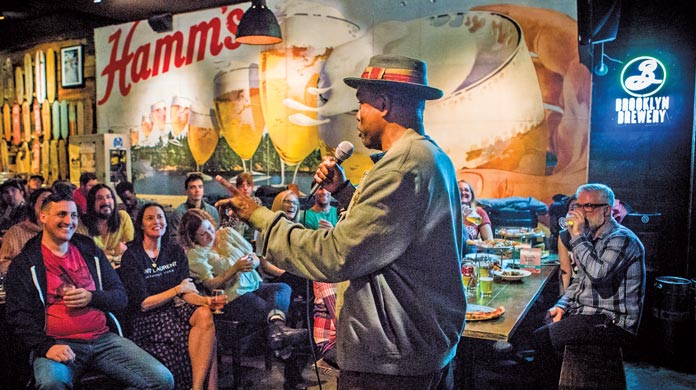
Brooklyn Brewery happened before the phenomenon of craft beer and you have continued to thrive after. What’s your read?
We have always stayed ahead, through innovation, through flavor and through technical quality. We were the first brewery to do collaborations between breweries, the first to brew beers based on cocktails, the first to do so many things. Today we sell more beer outside the United States than in the States. This is a purposeful thing – we always traveled, we always learned, and now people around the world enjoy what we’re doing. A craft brewery needs to stay creative and vibrant to succeed, and I think we’ve always kept things humming.
Did major breweries come in to buy the big craft brands to shut them down or to grow them?
Some big brewers just wanted to join the craft beer party and others came to try and shut it down. But in the end, they all discovered that craft beer is not a “fad”, it’s a return to normality. Craft beer is part and parcel of the renaissance of American food, plain and simple. And it’s never going back to the way it was before. So larger breweries buy craft breweries to generate growth and instill creative DNA that’s lacking on the industrial side. Craft beer can’t be “defeated”, because craft beer is what most people will eventually want. More and more people want food and drink that has real character. Craft beer is growing for exactly the same reason that salsa and sriracha sauce now outsells ketchup.
What are the priorities for a brew master? Are you always looking for the next flavor? Do you think in season?
We think in season and yes, we always do try to be creative. But the fundamentals – quality, balance, structure, and elegance are key. We’re not a bunch of kids looking to impress you with crushing bitterness or strange flavors. We want to make beers that you – and we – think are delicious. Deliciousness comes above all things.
Do you look at your business from a distribution/point or sales standpoint? How does the on-prem/restaurant target different from the liquor store/retail consumer?
Customers consume beer very differently venue-to-venue, so we look to meet them where they are. Brooklyn Lager remains our flagship and the lead horse; everyone knows it and it’s very popular. It does well both in bars and restaurants, but also at baseball games and clubs. These days it’s not considered “fancy”, just “really good”, and we’re happy about that. There are some types of beer that we make that really play strongly in specialized on-premise, such as barrel-aged draft beers. Barrel-aged bottled beers such as our Brooklyn Black Ops (12.3 % ABV, aged one year in Four Roses Small Batch barrels) are usually bottle-by-bottle sales in better supermarkets and specialty stores. We make over twenty different beers every year, some of them seasonals like Brooklyn Summer Ale, so we can hang with you from the beach to the fireplace.
What impact has the advent of the “Cicerone” had? How has that impacted how chefs and restaurants look at the role of beer on a menu? Better/more creative on-prem marketing, flights, etc.?
The Cicerone program has had a large impact on both restaurants’ and customers’ outlook on beer. For many years most restaurants were simply leaving money on the table by not giving customers the beers they actually wanted to drink. The customer had more and more sophisticated tastes, but the restaurants lagged well behind. It was not at all uncommon to have many of a restaurant’s customers know the beers on the list better than the restaurant’s own beverage manager. That’s changing, and it’s partly due to Cicerone and other educational opportunities. We’re involved with the beer education program for the Culinary Institute of America (CIA), for example.
But it’s not an easy road. That’s partly because many beverage managers don’t understand how to fit better beer into their beverage programs. They are often afraid that a beer sale will replace a wine sale, resulting in a loss of that huge wine margin. In real life, that never happens – I’ve never seen it once. Smarter operators will pair beers with apps, desserts and cheese, resulting in a higher check average and a happier customer. What’s interesting is that my first book, “The Brewmaster’s Table”, which was first published in 2003, sells better now than it did five years ago. And “The Oxford Companion to Beer” is still going strong. I think that’s indicative of the growing public interest in beer. In 2014 I became the first brewer to win the James Beard Award for “Outstanding Drinks Professional”, and two other brewers have won it since. In the past, that award was won almost exclusively by wine people. So yes, the culinary world is definitely changing.
What advice do you have for the foodservice operator trying to rethink the “Bud/Coors” mentality?
Thankfully, what we used to call the “gas station beer list” is slowly dying out. People have figured out that if your list is made up of mass-market beer, you’re going to lose customers and the guests that do show up will be folks who ring lower check averages. Craft beer drinkers are much better customers for restaurants than mass-market beer drinkers, and it’s not hard to see why. But some people are replacing one monoculture for another. For example, if you have three hazy IPAs on your beer list, you’re probably missing some opportunities.
I think that good brewers and distributors need to understand the restaurant and bar operator’s world and try to help them improve their businesses. Walking in the door and saying “Hey, you should carry my beer because it’s great” isn’t doing anyone any favors – there are 8,000 breweries in the United States. So you’d better be able to do better than that. Thankfully, we can.
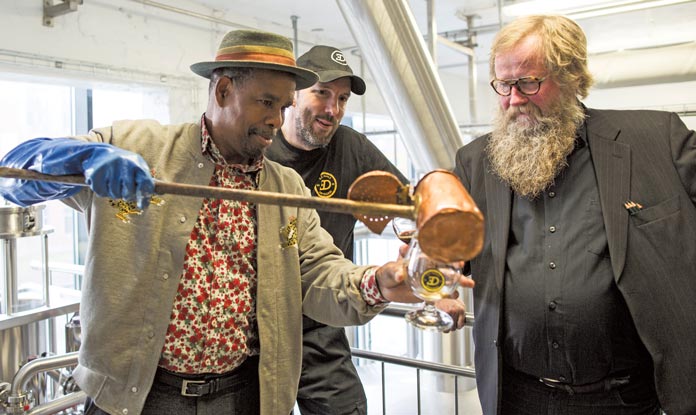
You have the unique perspective of traveling the world? What is going on in the world of beer that we should be looking for here?
I’ve had the privilege of watching the United States go from the laughing stock of the world when it comes to beer (we all remember the “American beer jokes”, which I won’t repeat here!) to the leading light of the beer world. Today, if you go to London, Paris or Stockholm, you’ll see Brooklyn Brewery’s beer everywhere. That’s amazing. And these countries have their own burgeoning beer scenes too. I just did a five-city tour of China back in October, and the beer scene is starting to pop there too. They’re applying their own food culture to new beer styles and creating types of beers we haven’t seen before. In Brazil brewers are adding fruits that most Americans have never even heard of to beers and making some fantastic things. So these days brewers travel like chefs and get inspirations everywhere.
One of the keys to what you have built at Brooklyn Brewery has been through on-going community involvement. The latest is your involvement with a potential Food and Beverage Museum. Can you talk about the initiative and the upcoming African-American exhibit?
I’m on the board of the Museum of Food and Drink (MOFAD), which seeks to build a world-class museum here in New York City. Would you believe that despite the centrality of the table in all of our lives, that there is no museum of food and drink in the world? Sure, there are museums of particular foods – a “museum of pasta”, for example. But nothing equivalent to a great art museum or natural history museum. So we’re building it, but it takes time. Right now, we’re in small spaces, building bigger and better exhibits.
The next exhibit, opening in a couple of months (late winter), is our most ambitious to date. It’s called “African/American: Setting The Nation’s Table”, and it tells the fascinating story of the African-American contributions to all of American cuisine. Everyone knows barbecue and soul food, but most Americans have no idea that European haute cuisine was brought into the United States, practiced, taught and promulgated almost entirely by African-Americans. It’s a super interesting story both as culinary history and as social history, and we’re going to tell it with verve. We actually have acquired and restored the original “Ebony Magazine” test kitchen from the 1970s, which will be part of the exhibit. We’re going to have artifacts, virtual reality stories, and actual food for visitors and it’s going to be a real cultural milestone and I think our visitors will be spellbound.
We’ll be located at the top of the Museum Mile on 5th Avenue across from the corner of Central Park at The Africa Center. As we go, we’re fundraising to eventually build the full-scale museum. I mean, come on – we all know in our hearts that done correctly, MOFAD would become one of the most-visited museums in New York City; it’s a no-brainer. It’s very ambitious, but building museums is not for the timid!
Crystal Ball… As you look towards 2020, what’s on the agenda?
We’re developing whole new ranges of beer, so things are very busy indeed. Our non-alcoholic beer, Brooklyn Special Effects, is going like a rocket. We’ll be adding more non-alcoholic beers to our range and giving our customers more options to drink tasty stuff from Brooklyn Brewery. I’ll be traveling to at least ten countries, working on television and writing projects, putting together new ventures with chefs, distillers, winemakers and other partners… 2020 is going to be quite a year!
To learn more about Garrett Oliver and Brooklyn Brewery, visit their website




















